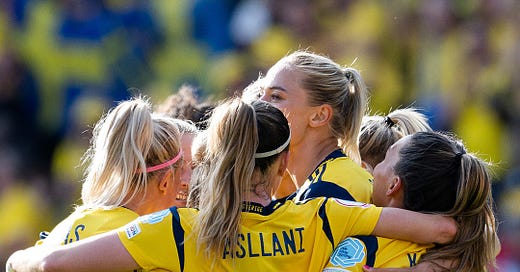How Sweden Fits Into the Tactical Theory of Rest Attack
The Swedes are good at turning their defensive prowess into offensive movements
In my previous post, I talked about the benefits of Sweden’s narrow shape and the connections and the triangles they were able to form because of it.
This post takes it a step further and looks at how Sweden’s shape is conducive to rest attack situations.
I came across an article written by Judah Davies for Spielverlagerung. In his article he fleshes out the concepts behind rest attack.
Rest attack is the opposite of rest defense: the anticipation and preparation done by players on the team not in possession in order take advantage of a ball recovery through an offensive transition and or counterattack.
What makes Sweden primed for rest attack?
A look at their stats from the group stages via The Analyst will tell you that they had the most High Turnovers (the number of sequences that start in open play and begin 40 meters or less from the opponent’s goal) with 58.
They only trailed Spain in Passes Per Defensive Action (PPDA: number of opposition passes allowed outside of the pressing team’s own defensive third, divided by the number defensive actions by the pressing team outside of their own defensive third. A lower figure indicates a higher level of pressing). Spain had 6.2 PPDA while Sweden had 7.9.
Their defensive effort can be seen in the individual stats as well. Sweden was the only team with 2 forwards that had 26 or more ball recoveries (when a player takes possession of a loose ball). You can read about this underrated aspect of Asllani’s game here.
Player Roles
Before looking at examples of Sweden’s rest attack, it’s important to share the definitions of the roles in transition given by Davies in his article:
Wide Runners/Carriers: players facing forward that are positioned as wide as needed to be able to do so
Binder: high positioned player that pins defenders and makes runs through back lines
Connector: centrally positioned player that is there to combine with teammates or move out of space to drag defenders away
Rest Attack Set Up in High Areas
The following examples demonstrate the effectiveness of Sweden’s press. They regained possession in their attacking third and have an offensive transition close to the opposition’s goal.
Rest Attack Set Up in Deeper Areas
While they are a high pressing team, some of Sweden’s best transitional moments came when they regained possession in deeper areas.
As Davies points out in his article, the earlier teams win back possession, the opposition will be more disorganized, but there will be less space.
When Sweden recovered the ball in deeper areas, the opposition may have been more organized, but they had more space to work in.
The next two frames are from the same sequence.
Conclusion
Sweden has been my favorite team to watch at the Euros so far because of their tactical set up. Collectively they may not be the most technical group (they have a few players who are), but their discipline, commitment and execution of their tactical ideas has been fun to watch.
As I mentioned in my previous post, their shape and defensive set up is something they can lean on to create offensive opportunities as they move into the knockout rounds of the tournament.












